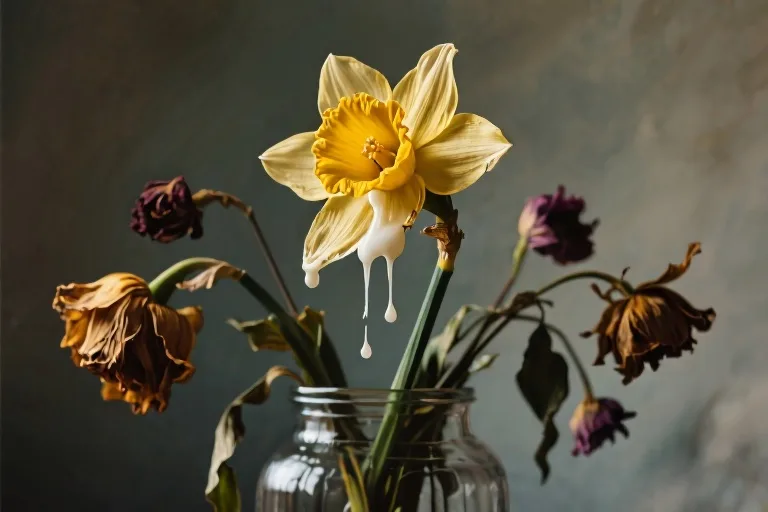The riverbank was still, the water’s surface a flawless mirror reflecting the golden-haired youth kneeling at its edge. Narcissus leaned closer, his breath disturbing the glassy plane as his lips brushed against the illusion. In that fatal moment, the ancient Greeks captured a truth modern psychology would later validate: what we call narcissism isn’t simply self-love—it’s the tragic confusion between one’s reflection and genuine connection.
Statistics reveal a sobering reality: while only 1-5% of the global population meets clinical criteria for Narcissistic Personality Disorder (NPD), over 60% of their intimate partners report experiencing psychological harm. This disparity begs the question—why does the narcissist’s version of ‘love’ act like daffodil sap, beautiful yet poisonous to surrounding relationships?
The myth provides our first clue. When Narcissus whispers devotion to his watery reflection, he demonstrates the core wound of narcissistic personality disorder—the inability to distinguish between self-projection and authentic emotional bonding. Like the narcissus flower (known colloquially as daffodils) that sprouted where he died, these individuals often isolate themselves through behaviors that inadvertently poison their relational ecosystem.
Modern therapists recognize this pattern as ‘trauma reenactment.’ The original Greek text hints at deeper layers—Narcissus was conceived when the river god Cephissus raped the nymph Liriope. Abandoned by his father and raised by a mother who saw her assailant in her child’s features, Narcissus learned to approach love through the distorted lens of inherited pain. His eventual obsession with the river reflection wasn’t vanity, but unconscious gravitation toward the aquatic symbol of his traumatic origin.
This intersection of myth and psychology offers profound insights. Water serves as the perfect metaphor—fluid enough to reflect any image, yet incapable of sustaining true connection. Similarly, narcissists often attract partners through charismatic ‘mirroring,’ only to reveal their emotional toxicity when relationships deepen. The daffodil comparison holds scientific merit too; Lycorine alkaloids in their sap cause vomiting if ingested, just as narcissistic abuse can induce psychological nausea in victims.
Understanding this dynamic changes everything. What society dismisses as mere selfishness reveals itself as a profound relational disability—the narcissist literally cannot see beyond their own trauma-distorted reflection. Their ‘love’ operates like a botanical defense mechanism, isolating them as effectively as the daffodil’s chemical warfare against neighboring flowers. The healing begins when we stop mistaking their poisonous projections for genuine affection, and learn to protect our emotional gardens accordingly.
The Boy in the River: A Trauma Origin Story
Narcissus’s story begins not with a boy gazing at his reflection, but with violence rippling through generations. His father Cephissus, the river god, assaulted his mother Liriope in what ancient texts describe as a ‘torrential taking.’ This primal scene shaped Narcissus’s psyche long before he ever knelt by the water’s edge.
The Weight of a Mother’s Gaze
When Liriope held her newborn son, she didn’t see an innocent child – she saw her rapist’s features mirrored in miniature. Psychologists call this ‘traumatic transference,’ where victims unconsciously attribute their attacker’s qualities to others. Every childhood milestone became layered with unspoken tension:
- First steps: “He moves like his father”
- Adolescent defiance: “The same cruel streak”
- Emerging attractiveness: “Danger blooms again”
Modern attachment theory explains how such distorted mirroring prevents healthy self-concept development. Without accurate emotional reflections from caregivers, children like Narcissus construct identities based on others’ wounds rather than their own essence.
The Abandonment Paradox
Cephissus’s disappearance created another psychological trap – the simultaneous burden of paternal rejection and maternal over-attention. Narcissus grew up bearing:
- The shame of being unwanted
- The guilt of being “too much” like his father
- The impossible task of healing his mother through filial love
This triple bind created what psychologists now term ‘narcissistic hunger’ – an insatiable need for validation to compensate for early emotional malnutrition. The river where Narcissus later lingered wasn’t just water; it became the symbolic space where he sought what his parents couldn’t provide: perfect, unconditional admiration.
From Myth to Modern Understanding
Contemporary research on Narcissistic Personality Disorder (NPD) reveals startling parallels:
- Genetic factors: Children of abusive parents show 50% higher NPD predisposition
- Environmental triggers: Emotional neglect combined with intermittent praise creates ideal conditions for narcissistic traits
- Neurological impacts: fMRI scans show NPD individuals have reduced gray matter in empathy-related brain regions
Yet the myth reminds us these aren’t mere statistics – they’re lived experiences. When Narcissus whispers “I see love through the…” his unfinished sentence echoes in therapy rooms today, where patients struggle to articulate how early wounds distort their capacity for connection.
“Trauma doesn’t just happen to you – it happens through you,” notes Dr. Eleanor Voss, author of The Narcissus Complex. “The child who serves as a constant reminder of violence becomes both the repository and reenactor of that pain.”
This understanding shifts how we view narcissistic behavior – not as vanity, but as a survival mechanism gone awry. The same protective walls that helped young Narcissus endure his mother’s haunted gaze eventually imprisoned him in solitary self-regard.
Breaking the Reflection
Three therapeutic insights emerge from this origin story:
- Recognize the wound behind the armor: Grandiosity often masks profound shame
- Identify transgenerational patterns: Abuse survivors may unconsciously recreate dynamics
- Reframe self-absorption as self-preservation: What begins as protection becomes pathology
Like water shaping stone, these early experiences carved neural pathways that would later determine how Narcissus – and modern narcissists – experience love. Not as mutual connection, but as a desperate attempt to fill the empty spaces where healthy attachment should have grown.
The Solitary Bloom: Why Narcissists Poison Their Own Gardens
Narcissus flowers carry a dark secret beneath their cheerful yellow petals. While they brighten spring gardens, florists know never to mix them with other blooms in bouquets. A single broken stem releases lycorine—a toxic alkaloid that wilts neighboring flowers within hours. This botanical fact mirrors the emotional ecology of narcissistic relationships with eerie precision.
The Science Behind the Symbol
Research from the Royal Horticultural Society confirms what ancient florists observed empirically: daffodil sap contains lycorine concentrations up to 0.12%, enough to:
- Inhibit protein synthesis in other plants
- Block water absorption through stems
- Accelerate cellular decay in mixed arrangements
Dr. Elena Vasquez, a botanist specializing in plant chemical defenses, explains: “What makes narcissus flowers unique is their self-protective toxicity. When damaged, they don’t just defend—they preemptively eliminate competition.” This survival mechanism finds its psychological parallel in narcissistic personality disorder (NPD), where emotional self-preservation often manifests as preemptive rejection or devaluation of others.
Counseling Sessions: The Human Bouquet Wars
“I call it the vase effect,” says marriage therapist Dr. Jonathan Hayes, who’s treated over 200 NPD-affected relationships. “Partners describe feeling like fresh flowers suddenly starved of nourishment—not from neglect, but from active poisoning.” His case studies reveal three recurring patterns:
- The Broken Stem Scenario: When narcissists experience perceived criticism (their “broken stem”), they typically respond with:
- Projection (“You’re the toxic one”)
- Gaslighting (“That never happened”)
- Emotional withdrawal (silent treatment)
- The Monoculture Dynamic: Like daffodils thriving best in single-variety plantings, narcissists often:
- Surround themselves with admirers who don’t challenge them
- Sabotage friendships between their “supply” sources
- Feel threatened by partners’ independent social connections
- The Seasonal Cycle: Relationships follow predictable phases:
- Spring: Idealization (love-bombing, intense charm)
- Summer: Devaluation (nitpicking, comparison to others)
- Autumn: Discard (sudden abandonment or explosive endings)
- Winter: Hoovering (attempts to reconnect when needing supply)
Your Stories: Recognizing the Toxicity
We asked readers to share moments when they recognized narcissistic “lycorine effects” in relationships. Their responses paint a telling pattern:
- “My ex would compliment my dress, then ‘jokingly’ mention how it highlighted my cellulite—like giving flowers while snapping the stems.”
- “After I got promoted, my friend started ‘forgetting’ to invite me to gatherings. Later I learned she’d told everyone I’d become ‘too arrogant.'”
- “Every time I expressed hurt, my partner would list bigger pains they’d endured—as if suffering were a competition they needed to win.”
These accounts reveal the narcissist’s paradoxical approach to connection: creating bonds through shared pain rather than mutual growth, much like Narcissus seeking love through his traumatic reflection rather than another’s eyes.
The Greenhouse Effect: Self-Protection Strategies
Just as professional florists handle daffodils with care, those interacting with narcissists can adopt protective measures:
- Wear Emotional Gloves:
- Set clear boundaries before toxicity emerges
- Use neutral language during conflicts (“I see we disagree” vs. “You’re wrong”)
- Create Separate Arrangements:
- Maintain social circles independent of the narcissist
- Avoid becoming their sole emotional support
- Recognize Early Wilting Signs:
- Chronic fatigue after interactions
- Self-doubt creeping into decisions
- Making excuses for their behavior to others
- Know When to Change the Water:
- Therapy can help detoxify from emotional poisoning
- Support groups provide shared coping strategies
Like the wise gardener who appreciates daffodils from a distance, we can acknowledge narcissists’ humanity while protecting our emotional ecosystems. Their toxicity stems not from malice, but from the tragic inability to share space without contaminating it—a limitation as biological as it is psychological.
The River is Always Behind Them: Trauma Repetition
Narcissus didn’t just stumble upon that fateful river by accident. His relentless pursuit of watery reflections reveals a deeper psychological truth – for narcissists, trauma isn’t something that happened in the past; it’s the lens through which they view every present relationship. Modern neuroscience shows how early childhood experiences like Narcissus’s (born of rape, raised with abandonment) physically reshape brain structures related to emotional processing.
The Neuroscience of Broken Mirrors
Functional MRI studies reveal striking differences in how narcissistic individuals process emotional stimuli compared to healthy counterparts. Three key findings emerge:
- Hyperactive amygdala responses when perceiving potential rejection, explaining narcissistic rage outbursts
- Reduced orbital frontal cortex activity during empathy tasks, correlating with impaired emotional reciprocity
- Abnormal dopamine pathways creating addiction-like patterns in attention-seeking behaviors
This neural blueprint helps explain why narcissists, much like Narcissus returning repeatedly to the river, compulsively reenact trauma dynamics. The very regions meant to regulate emotional responses become hijacked by survival mechanisms – constantly scanning for threats, interpreting neutral feedback as attacks, and seeking validation as if it were oxygen.
The Trauma Loop in Relationships
Healthy individuals approach new relationships with curiosity and openness. For those with narcissistic patterns, every interaction gets filtered through unconscious questions:
- Will this person abandon me like my father did?
- Are they seeing me or just the shadow of my parents’ trauma?
- How can I control this situation before it controls me?
This explains the paradoxical behavior many observe in narcissists – simultaneously craving intimacy yet sabotaging genuine connection. Like Narcissus leaning closer to his reflection only to disturb the water’s surface, their attempts to secure love often repel the very connection they desire.
Breaking the Reflection Cycle
Understanding this trauma repetition pattern offers practical insights for those affected by narcissistic relationships:
- Recognize the river metaphor – Narcissists aren’t choosing to be difficult; they’re often drowning in unconscious trauma responses
- Set boundaries with compassion – Like handling toxic daffodils, protect yourself without demonizing
- Avoid reflection battles – Arguing with a narcissist’s distorted self-perception proves as futile as convincing Narcissus his reflection wasn’t real
Modern therapeutic approaches like trauma-focused CBT and schema therapy show promise in helping narcissistic individuals develop healthier relationship patterns. The path forward involves gently helping them see beyond the river’s reflection to recognize real, reciprocal human connection – something Narcissus himself never achieved.
“The tragedy of narcissism isn’t self-love – it’s being trapped in a hall of mirrors where every reflection shows the past instead of the present.”
Survival Guide for the Poisoned
Recognizing the Red Flags
When dealing with someone who exhibits narcissistic traits, it’s crucial to recognize the warning signs before emotional toxicity takes root. Here are three telltale attack patterns that emerge when narcissists feel threatened or wounded:
- The Blame Cyclone
Their criticism shifts from specific complaints to global character assaults. Phrases like “You always…” or “People like you…” reveal how they weaponize perceived slights to dismantle your self-worth. - Empathy Blackouts
Watch for sudden emotional disconnection during conflicts. Their pupils may constrict (a physiological stress response), and they’ll dismiss your feelings with clinical detachment: “That’s your interpretation.” - The Martyrdom Gambit
They reframe attacks as victimhood, often mid-conversation. “I sacrificed everything for you” morphs into “Now you’re punishing me.” This traps you in circular debates about their suffering.
Decoding the Language Trap
Narcissistic communication follows predictable scripts designed to maintain control. Break these patterns by spotting:
- Pronoun Politics
Healthy relationships balance “I” and “we.” Narcissists overuse “I” in victories (“I made this happen”) but switch to “you” in failures (“You made me do this”). - The Bait-and-Switch Compliment
“You’re so smart—unlike those idiots I usually date” backhandedly praises while isolating you from support systems. - Gaslighting Grammar
Phrases like “That never happened” or “You’re too sensitive” systematically destabilize your reality.
Emergency Detox Tools
Relationship Toxicity Checklist
Mark statements you’ve heard more than twice:
- [ ] “No one else would tolerate you like I do”
- [ ] “After all I’ve done, this is how you repay me?”
- [ ] “You’re lucky I put up with your issues”
Scoring:
✅ 1-2: Set firmer boundaries
⚠️ 3-5: Seek professional support
❌ 5+: Consider exit strategies
Creating Emotional Safe Zones
Protect yourself by:
- The 24-Hour Rule
Delay responding to inflammatory messages. Narcissists feed on immediate reactions. - The Broken Record Technique
Calmly repeat neutral phrases like “I hear you” without engaging in debates. - The Support Audit
Maintain relationships with at least three people they haven’t met—preserve outside perspectives.
Remember: Like daffodils that poison neighboring flowers when damaged, wounded narcissists project toxicity. Your emotional safety isn’t selfishness—it’s survival.
Cultivating Emotional Boundaries: A Survival Guide for the Poisoned
Narcissistic relationships often leave us feeling like flowers wilting in a toxic bouquet. Just as daffodils secrete poisonous lycorine when their stems break, narcissists release emotional venom when their fragile egos are wounded. The final lesson from Narcissus’s story isn’t about his tragic end—it’s about how we can prevent becoming collateral damage in someone else’s trauma reenactment.
Recognizing the Poisonous Patterns
Three telltale signs emerge when narcissists feel threatened:
- The Gaslighting Bloom: Like daffodils crowding out other flowers, they’ll insist your perceptions are wrong (“You’re too sensitive”) while monopolizing emotional space
- The Deflection Pollen: Attacks often come disguised as victimhood (“After all I’ve done for you”) much like how narcissus pollen causes allergic reactions
- The Silent Treatment Frost: Withholding affection becomes their weapon, mimicking how daffodils stunt nearby plants’ growth
Neurological studies show these behaviors correlate with heightened activity in the amygdala (fear center) and reduced prefrontal cortex engagement—essentially, they’re trauma responses frozen in time.
Building Your Psychological Greenhouse
Protecting yourself requires both practical strategies and mindset shifts:
1. The Root Barrier Technique
- Set physical/emotional distance like gardeners separate toxic plants
- Example: “I can’t continue this conversation when you raise your voice”
2. Photosynthesis Principle
- Redirect energy toward nourishing relationships as plants turn toward sunlight
- Practice: Spend 2:1 time with supportive people vs. narcissists
3. Seasonal Pruning
- Regularly assess relationship health using this checklist:
☐ Do I feel drained or energized after interactions?
☐ Is criticism constructive or character-assassinating?
☐ Are apologies reciprocal or nonexistent?
When to Uproot Completely
Sometimes the healthiest choice is removal. Consider professional help when:
- You experience physical symptoms (insomnia, appetite changes)
- Your self-worth becomes dependent on their approval
- The relationship shows no improvement despite boundaries
“Like skilled gardeners, we must learn which plants to nurture and which require quarantine.” —Dr. Eleanor Green, trauma therapist
Resources for Replanting
- The Narcissistic Abuse Recovery Workbook (free PDF)
- Crisis text line: Text HOME to 741741 (US/Canada)
- Therapist directory: PsychologyToday.com/NPD-specialists
Preview: The Weaponized Narcissist
In our next exploration, we’ll examine how narcissistic traits morph into psychological warfare through the myth of Medusa—where woundedness becomes a weapon, and victims turn vigilante. What happens when the poisoned daffodil learns to aim its toxins?
Remember: Your emotional garden deserves protection. If this piece resonated with you, consider sharing it with someone tending their own poisoned soil.





